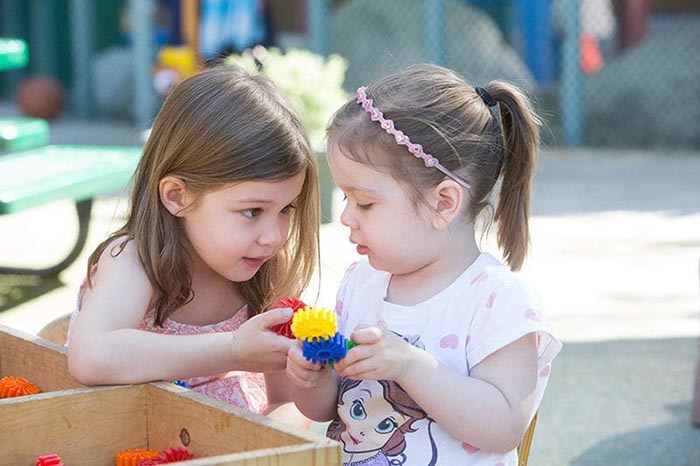
Access is critical, but so is giving young children classrooms full of warmth, support and meaningful activities
From The Hechinger Report
by ERIC DEARING and DALE C. FARRAN
March 15, 2022
As researchers involved with early care and education, we should be pleased that President Biden’s first State of the Union address underscored his administration’s commitment to public universal preschool. His plan could provide access for millions of children and families.
Yet, our excitement is tempered by concerns that children will not thrive if we put more “school” into preschool. We urge policymakers to move away from the belief that young children need two more years of “school” before kindergarten.
Preschool experiences can help set the stage for children to flourish academically, but an overemphasis on teacher-led instruction of school-readiness skills may do just the opposite. The early childhood brain evolves to flourish not through rigorous schooling, in any traditional sense, but through exploration, interaction and conversation. The surge in neural pruning and plateau in cortex volume that characterize the middle childhood brain remain a few years away for the preschooler — and so should traditional schooling.
Science shows us precisely what high-quality early childhood classrooms should look like: full of warmth and support with multiple chances to explore the world while having rich conversations with teachers and classmates.
Having the “right” curriculum cannot make a pre-K classroom high quality, but well-trained teachers can; high-quality classrooms have teachers who stimulate and then build on children’s interests; design spaces where children have some autonomy; talk with children in ways and on topics that keep them engaged; and open the world for children to safely experiment.
But recent research by the second author of this essay, corroborated by other researchers, has shown that preschool for many children features didactic, teacher-led instruction in large groups, with few opportunities for children to actively engage with learning materials, few conversations between teachers and children and more time spent standing in line than playing indoors or outdoors.
Ironically, this instruction-heavy trend has been spurred by the same justifications as those used for expanding pre-K access: that early care and education have the potential to improve children’s achievement and can help children who are growing up in poverty catch up to those from more affluent backgrounds.
The logic is that because children from low-income families often start school without the school-readiness skills they need to succeed, pre-K can be a place for children to learn those skills. This mind-set has, however, increasingly led to classrooms that prioritize direct instruction of basic academic skills at the cost of building knowledge through exploration and play.
If we continue and expand this instruction-heavy trend, the danger for children from low-income families is that early education will perpetuate systemic disadvantages rather than help erase them. It’s telling that pre-K classrooms with rigorous instructional practices are often not the ones preferred by families who have the luxury of choice.
Families with means are typically choosing more experiential learning environments; some are even “redshirting” their children — holding them back from academically demanding kindergartens and giving them more time to learn through active exploration and play.
Moreover, academic gains from pre-K are often ephemeral — mostly gone by the end of kindergarten. Even more alarming, long-term data from the only randomized control trial of a statewide instruction-heavy pre-K program, in Tennessee, shows negative effects on both achievement and behavior.
Why these negative results? As noted, young children’s learning happens through active engagement in problem-solving, exploration and investigation. Yet, problem solving and learning through exploration are difficult in large groups, where teacher-dominated instruction means children must sit passively and behave “appropriately” for long periods of time.
Active learning can happen in smaller group activities, but presently small group interactions are all but absent from many preschool classrooms.
Adults are, without question, critical to young children’s learning. Yet, as the cognitive scientist Alison Gopnik has argued, they should be more like gardeners than carpenters, providing an enriched environment and scaffolds for growth rather than attempting to construct a child’s mind piece by piece.
Children should have meaningful conversations and be able to ask questions. Hearing others talk — including teachers — is not enough for children to learn.
Unfortunately, Harvard researchers found that teacher talk often takes up 60 percent or more of pre-K classroom time. Helping children engage in meaningful conversations is a skill, and one that takes training. In this area too, the science is clear: Teachers can be trained to be better conversation starters and supporters.
While international comparisons should not naively guide U.S. policy or educational practice, they can suggest alternatives to consider. The first author of this essay has for the last decade been studying early child care and education in Norway, where universal, publicly supported programs begin at age 1. By U.S. standards, Norway does not have a rigorous academic focus in early education, but evidence of lasting achievement benefits continue to accumulate there.
One of the most striking differences, is that children in Nordic countries spend significantly more time playing outdoors, no matter the weather. In the U.S., time spent playing, indoors and outdoors, has been curtailed as one of the costs of the increasing focus on academic preparedness.
Ensuring that investments in early childhood will result in high-quality experiences for children requires a seismic shift away from trying to improve a narrow range of academic skills through teacher-dominated instruction. The Biden administration’s plans to fund public pre-K can have effects contrary to expectations unless they include a commitment and a system for creating warm, supportive classrooms that surround children with chances to explore and talk about their world.
Photo: Bright Horizons
Read this and other stories at The Hechinger Report

